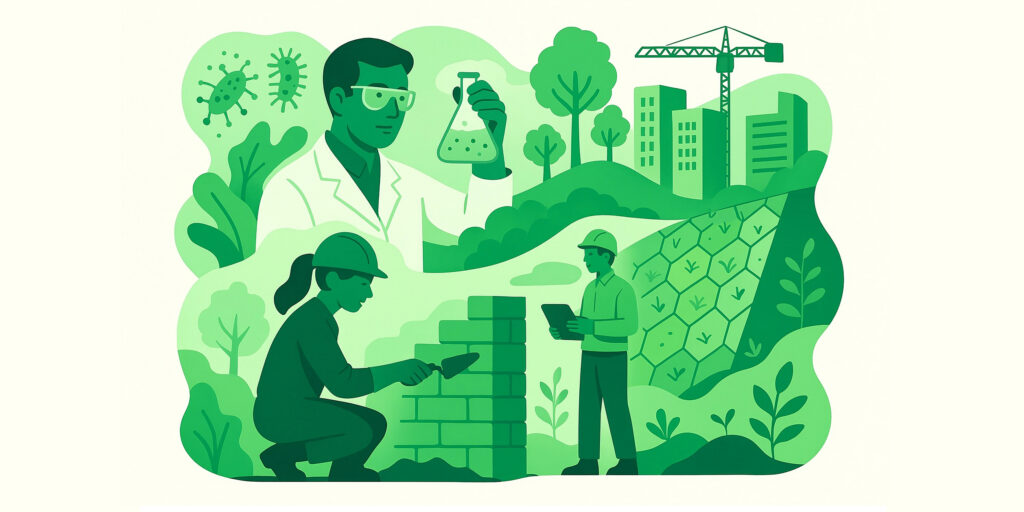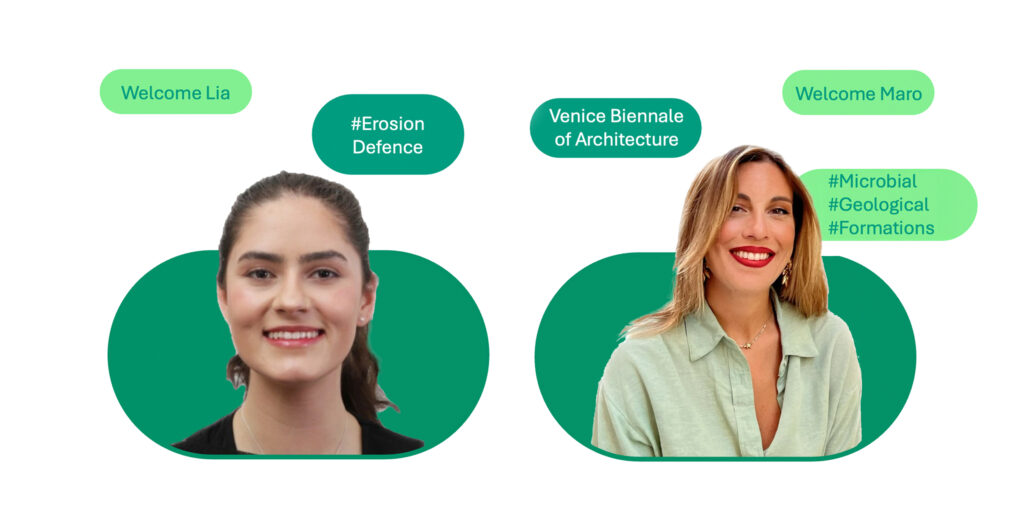A new class of
organic binder
products designed
to serve earthworks
and building applications
A new class of
organic binder
products designed
to serve earthworks
and building applications
Discover the future of sustainable construction with our innovative organic binders. Our eco-friendly solutions excel in soil consolidation, foundation strengthening, and transforming building waste into valuable resources.
experience
Clients
Support
projects
Discover the future of sustainable construction with our innovative organic binders. Our eco-friendly solutions excel in soil consolidation, foundation strengthening, and transforming building waste into valuable resources.
Support projects
Clients
Sustainability at the core of our innovation
Transforming construction with green tech:
Traditional binders relying on synthetic chemistry and petrochemicals are seen as outdated. They drain natural resources, compromise groundwater, and generate high CO2 emissions through energy-intensive proceses that often disrupt the built environment.
55% lower CO₂ emissions: cut your carbon footprint significantly with our advanced organic binders.
Protects soil & groundwater: safeguard essential natural resources by respecting soil and groundwater pH levels.
Minimal invasive techniques: achieve top-notch structural integrity with zero waste generation.
Sustainability at the core of our innovation
Transforming construction with green tech:
Traditional binders relying on synthetic chemistry and petrochemicals are seen as outdated. They drain natural resources, compromise groundwater, and generate high CO2 emissions through energy-intensive proceses that often disrupt the built environment.
55% lower CO₂ emissions: cut your carbon footprint significantly with our advanced organic binders.
Protects soil & groundwater: safeguard essential natural resources by respecting soil and groundwater pH levels.
Minimal invasive techniques: achieve top-notch structural integrity with zero waste generation.
4 principles of our solution
Nature based
Engineering
Efficiency in execution
Circularity
Application cases
Erosion mitigation
Demolition waste valorization
Improving bearing capacity
Slope stabilization
Mitigation of soil desiccation





News
Subscribe to our Newsletter
Subscribe to our newsletter to keep up to date with our news.
Subscribe to our Newsletter
Subscribe to our newsletter to keep up to date with our news.
Q&A
What is your vision?
Organic and bio-based products have driven significant improvements and changes in material usage across many industries, from food to pharma and energy. We developed cutting-edge solutions inspired by these processes to achieve a paradigm shift in the field of building materials.
What drives you?
We are driven by a deep understanding of tomorrow’s challenges that will impact the building sector as a whole, with a focus on geotechnical, geoenvironmental, and building materials waste issues. We empower our customers to address challenges related to the long-term well-being of infrastructures and the environment.
How far you’ve come?
Since becoming operational in 2021, and through 2023, we have delivered dozens of projects and established our fully industrial fixed and mobile biocementation plants. By developing new markets and partnerships across sectors, we accelerate our efforts to become a key catalyst for efficient building applications.
What does bio-cementation mean?
Bio-cementation is a process that uses natural soil and water microorganisms to create cement-like bonds in the ground. The term “bio” refers to the involvement of these living organisms in forming the strong mineral and polymer links.
What happens to the “bio” element once this is used ?
The microorganisms are taken from soil or water and grown in large reactors. Once ready, the minerals they produce are added to the soil. The microorganisms stay active in this closed system, continuing to multiply and create more mineral links.
What are some examples of the application of biocementation?
Applications range from soil consolidation and improving bearing capacity to geo-environmental work, such as controlling erosion caused by water or wind. Check out our projects section to learn more.
What is the cost of the products?
The cost of the mineral additives themselves is fixed. The required amount to meet your project’s specifications varies depending on various factors. To learn more, check out our quote field or reach out with your project details.
What is the core innovation of your products?
By deploying conventional industrial biotech approaches, we have established an advanced production system that meets technical, environmental, and cost performance standards. Our patented solutions valorize and reuse all materials used in production, achieving a fully circular model at affordable prices.
Why choose biocementation over other traditional techniques?
The combination of easy-to-use fluids with the viscosity of water, a pH between 7-8.5, and competitive pricing makes biocementation a durable and efficient solution for your projects.
How does it work practically?
In most projects where soil permeability allows, low-pressure injections are recommended. Other approaches include soil mixing or shotcrete-style applications to achieve the desired distribution and meet project specifications.
What are the downsides?
For biocementation to be efficient, local geological and environmental conditions must be considered. This is done using advanced tools and design principles developed by our teams based on experience from dozens of projects.
For silty sands to gravels, injections or a system of wellbores (e.g., injection/extraction) is advised. Soil granulometry, permeability, and depth are parameters that influence the design, as does the presence of a water table. For clayey soils, soil mixing is recommended, while for erosion prevention of topsoil, projection methods are used.
What is the cost of the solution?
The cost is directly related to the desired content of the binder product, while the execution method varies depending on the location, accessibility, and other site conditions.
Do you have experience working with all types of soils?
Yes, we have experience treating various soils, from reducing the swelling and shrinkage potential of clays to protecting sandy gravels from liquefaction or erosion. We equally focus on crushed and excavated aggregates, which are difficult to valorize using traditional binders. Our solutions cover a wide range of geologies to improve mechanical and hydraulic characteristics.
How long does the treatment last?
The mineral composition of our binder products is based on calcite, an abundant element in geology. No leaching has been observed after accelerated tests and over a decade of experience with the product. Guarantees follow traditional industry standards and range from 5 to 10 years.
What happens to the soil permeability?
For binder contents below 5%, permeability is not reduced by more than an order of magnitude. If the goal is topsoil erosion mitigation, we can locally create resistive to fully impermeable zones.
How can I request an offer?
Our offers are based on understanding the specifications of your project. Feel free to reach out to our team of engineers with your project details. If you are active in EU markets, contact our partners at anobin.com.
What are some hands-on examples of your projects?
Take some time to explore our dedicated project list.




